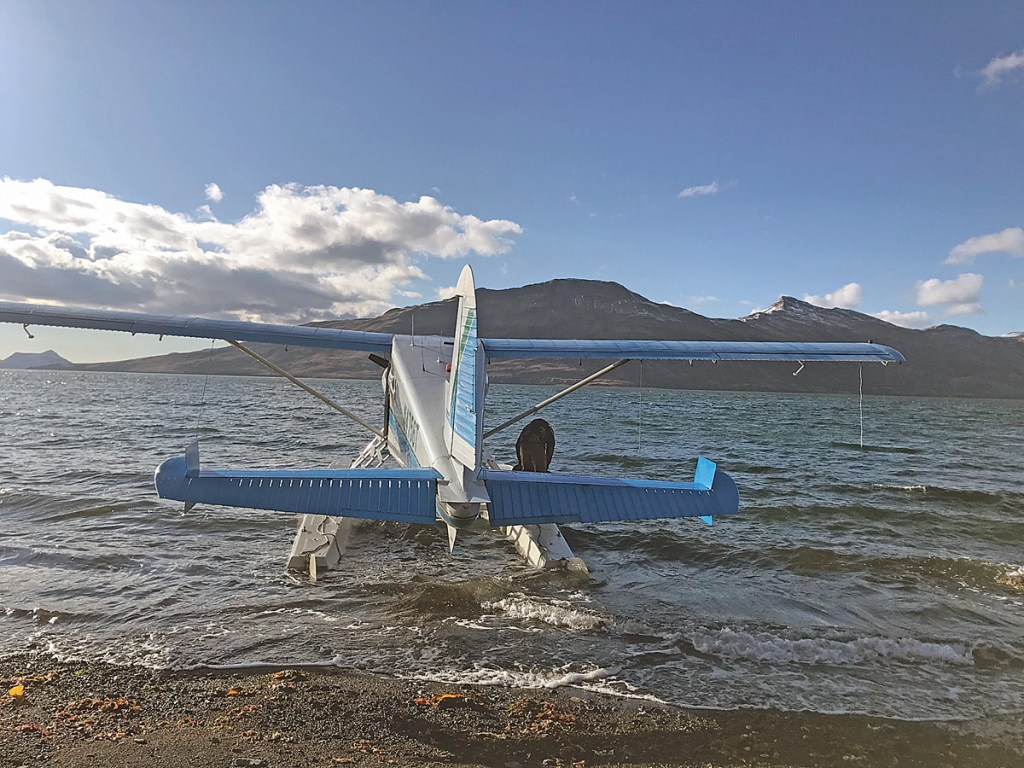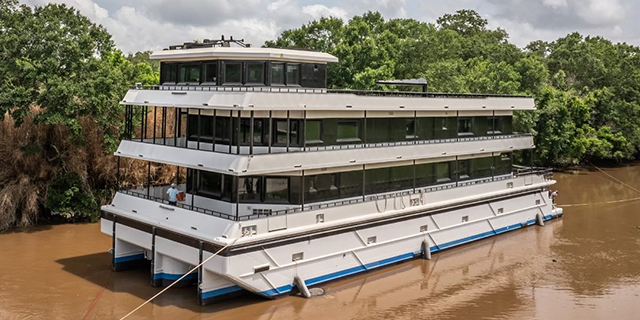‘Really big bear’ for Romero
Published 1:30 am Sunday, August 11, 2019

- A DeHavilland Beaver float plane provided the transportation for New Iberia hunter Shane Romero and Freelance Outdoor Adventures hunting giudes Brandon Hamilton and John Rydeen.
BY don shoopman
THE DAILY IBERIAN
Through the lens of his .375 H&H rifle’s telescope, with a main tube diameter of approximately 1 ½ inches that belies its magnification capabilities, Shane Romero could see all he wanted to see of a huge Kodiak brown bear charging at him and two hunting guides on the Alaska Peninsula.
The 1,200- to 1,400-pound bruin was hit by a .375 bullet fired by Romero a few moments earlier at a distance of 260-270 yards on the next-to-last day of April. The veteran hunter from New Iberia chambered another bullet and could see in panoramic vision the alders shaking and breaking like twigs as the Kodiak brown bear hit full stride in a downhill sprint toward the hunters.
At 155 yards, the bear stopped and inexplicably turned broadside, which gave the hunter a brief opportunity to fire a second shot. The impact caused the bear to waver for a second, then continue its run at their location.
It collapsed 40 yards away.
“Yeah, you know, after the first shot, it came on a charge for whatever reason. I watched the whole thing through my rifle scope,” Romero said last week while talking on his cell phone about the wild game trophy hunt of a lifetime. Perhaps, he said, it was because of the sow they saw earlier in the immediate area.
“For whatever reason, it stopped. The second shot was a perfect double-lung shot,” he said.
Brandon Hamilton and John Rydeen, hunting guides with Lance Kronberger’s Freelance Outdoors Adventures, walked to the bear.
“When we walked up, Brandon looked at me with a smile and said, ‘That’s a big bear, a really big bear,’ ” Romero wrote in a description earlier this summer about the hunt in Alaska.
“They have the biggest bears in the world. You don’t go to Kodiak to shoot a small bear,” Romero said as he continued his recent cell phone conversation.
It really was “a really big bear.” An Alaska Department of Fish and Game biologist who sealed the hide and skull after it was measured and submitted for biological samples, which is required by law of non-resident Kodiak brown bear hunters in Alaska, measured the squared hide at 9 feet, 10 inches, and the skull at 28 2/16 inches, a Boone & Crockett record book bear.
Hamilton certainly knows how heavy part of the bear was after the three men skinned it for nearly three hours until 10:30 p.m., then hiked 2 ½ hours with headlamps on through the mist before reaching base camp at 1 a.m. on April 30. The hunting guide said it was the third-heaviest bear hide, which he estimated at 160 pounds, he’d ever packed out of the remote wilderness.
Dewey Wildlife Studio LLC is making a full body mount at its Cody, Wyoming, custom taxidermy site.
“Hopefully, it can fit in the house,” Romero said with a chuckle.
While the trophy was shot on the fourth day, it was his 19th day of Kodiak brown bear hunting in Alaska. He had spent 15 days in 2015 without harvesting one of the bears that live exclusively on the islands in the Kodiak Archipelago and have been isolated from other bears for nearly 12,000 years.
After that hunt four years ago, Romero began planning another Kodiak brown bear hunt in Alaska. He scheduled it for May 1-15, 2019.
However, on April 19, an email from Freelance Outdoor Adventures informed him the first set of hunters finished their trip early and he was welcome to fly sooner than the scheduled time. He reworked his itinerary to leave April 24 out of New Orleans.
Mechanical problems caused him to miss connections in Seattle, then Anchorage, and he spent the night in Anchorage. He arrived in Kodiak in a snowstorm the morning of April 25.
That afternoon he boarded a DeHavilland Beaver float plane at Seahawk Air to go to the Aliulik Peninsula, the lower end of the 3,595-square mile Alaska island, he said, where he met up with Rydeen and Hamilton. The men unpacked tents, stoves, food, cots and a Zodiac inflatable raft to prepare for the hunt the next morning. Alaska regulations prohibit hunting and flying on the same day.
Day 1, April 26, was “as nice a day as you will see on Kodiak,” he said. They loaded the Zodiak and took a four-mile boat ride to the back of a bay where they hiked a short distance to a spot they glassed for bears the rest of the day.
Rydeen pointed out it was too sunny and that bears don’t move until about 6 p.m., Romero said. They hunted until 9:30 p.m., he said, and saw eight to 10 bears.
Day 2 was cloudy and misty. After boating and hiking to the same area as the previous day, the weather got nasty and they stayed under a tarp most of the day.
However, around 6 p.m., they spotted a 9-foot class bear a few miles away at the head of a bay, Romero said.
“That’s not your bear,” Rydeen said as Romero recalled in his written description, noting they saw six bears that day.
The weather got worse and they started back to camp at 8:30 p.m.
On Day 3, the hunting party was greeted with steady 35 mph winds, which made it too rough to cross the water in the raft, so they hiked half-mile to different location. The day, Romero said, was just as Kronberger advertises, “Specializing in cold, wet and miserable.”
Heavy rain was pounding the tent when they woke up the next morning, Day 4, he said. The forecast called for continuous rain through May 2.
But there was a break in the inclement weather. Rydeen wanted to go hunting.
After their three-mile hike from base camp on the fourth day, while crossing a small basin, they spotted a bear better than a 9-footer they saw two days earlier. But it wasn’t the bear they wanted.
Hamilton used his spotting scope and called for the New Iberian to take a lot at a bear three-quarters of the way up a mountain laying down on a ledge.
“I think this one has potential,” Hamilton told Romero.
It was less than 10 minutes but felt like half-an-hour, Romero said, before the bear stood up. Both guides talked about the bear’s ivory white claws and said it was a “really good bear.”
At 6:05 p.m., the hunters shouldered their backpacks and traversed a small canyon. After climbing to the other side, they relocated the bear 800 yards away … but there was a sow between them at 380 yards, which eventually spotted them and ambled out of sight.
They moved to within less than 300 yards of the Kodiak brown bear and dropped their backpacks. Hamilton put hit backpack on top of Romero’s for the hunter to rest the rifle and take a steady shot.
Hunting brown bears, a saying goes, is 99 percent boredom and 1 percent excitement. That 1 percent gave him a lifetime of excitement after his first shot.
“It feels great to accomplish this because not too many people get the opportunity,” he said.
Approximately 180 Kodiak brown bears are killed each year under tightly controlled regulations, according to the Alaska Department of Fish and Game, noting there are an estimated 3,500 Kodiak brown bears, or 0.7 per square mile.
About 5,000 resident hunters apply each year for a chance at the 496 bear permits available to them. Out-of-state hunters must hire a professional guide, paying $10,000 to $21,000 per hunt, the ADF&G said.
There are two bear hunting seasons each year. The spring season is open from April 1 through May 15. The fall season is from Oct. 25 to Nov. 30. The bag limit is one bear (either sex) every four regulatory years.
Hunt times are restricted to one 15-consecutive day hunting period, which is declared when a permit is picked up (registration hunts excluded) in person at the ADF&G office in Kodiak.
A non-resident license is $160. A non-resident bear tag is $1,000.
“You know, I’m very fortunate that I get to go on these hunts. My family tolerates it. I’ve had a lot of success in my practice and I owe it to my clients,” he said.
Romero, who has been a lawyer for 20 years, earned his undergraduate degree from LSU and his law degree from Southern University in 1998.
He began hunting at a young age, probably in 1979 or 1980, he said, starting with dove hunts, then duck hunts, with Clifford Saunier and Roy Sonnier, friends of his father, Errol “Romo” Romero. He enjoyed dove hunting and duck hunting and still hunts ducks on his lease near Pecan Island, which he has been on since 1980.
Later, the young hunter was introduced to deer hunting by Dr. Doug Bernard, a friend and neighbor of the elder Romero, and Ken Patin, They hunted on a lease in north Texas, he said. On drives to the deer hunting lease, he’d spend his time reading Field & Stream Magazine, especially the stories about moose hunting in Alaska.
Hunting in Alaska, he said, became his dream. His first venture was a moose hunt and he left the state without drawing a tag on that trip in 2005.
The guide he was with then urged him to try a doll sheep hunt, which he enjoyed.
He went on an unguided goose hunt in 2010 near Galena, Alaska, in the western Yukon. Later that year he went on an unguided caribou hunt with his brother-in-law, Dusty Rhodes, and Rhodes’ son, Zach Rhodes, in the Brooks Range region of Alaska. (The wilderness hunt was chronicled in a feature story in The Daily Iberian on March 13, 2011.)
Then Romero started setting his sights and dreams on bigger animals, such as Kodiak brown bears. That big one certainly filled his telescope.





